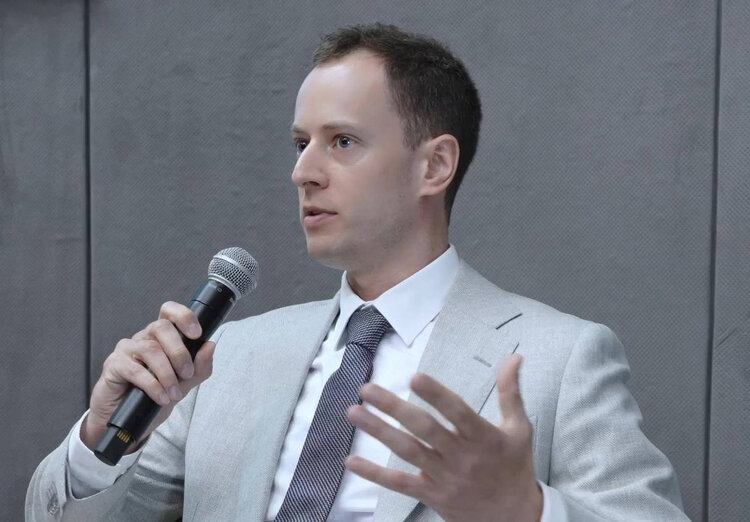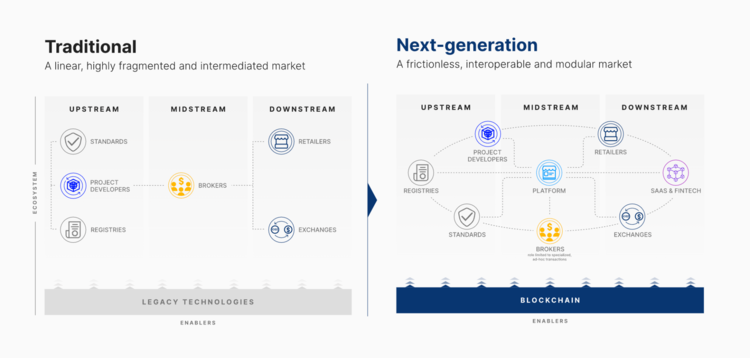Carbonmark co-founder: “Eastern Europe, Africa, and Southeast Asia will become carbon credit market growth drivers”
Andrew Bonneau speaks about getting rid of fraud in climate projects and the price of carbon credits for Ukrainian companies

The Paris Climate Accords, ratified by Ukraine, provides for international cooperation through market mechanisms in pursuit of the main goal of keeping global warming within 1.5-2°C.
This includes, in particular, trading in carbon credits – electronic certificates that confirm the reduction or removal of greenhouse gas emissions from certain projects. Companies can buy, sell, or use them to offset their own emissions, confirming their commitment to achieving carbon neutrality goals.
The use of carbon credits is not mandatory, but it is becoming increasingly common due to regulatory pressure on business involvement in climate protection.
They are traded on the Voluntary Carbon Market (VCM). The financial company MSCI estimated its volume last year at $1.5 billion, showing a slow growth in the number of credits accounted for since 2022. At the same time, the volume of carbon credits (the so-called transaction that certifies the offset of CO₂ emissions from commercial operations) remained stable for the fourth consecutive year and totalled 162.6 million units, slightly less than 163.7 million in 2023.
Shell, an energy corporation that is a leading player in the global LNG market, became the largest participant in withdrawals with a share of over 9% in the total volume of transactions. It is followed by such energy majors as Eni, Engie and Woodside.
MSCI analysts predict that the voluntary carbon market could reach $35 billion by 2030 and $250 billion by 2050. The reason for this rapid growth will be not only the expansion of the pool of credit consumers due to energy-intensive industries that will not be able to completely abandon fossil fuels and will publicly announce climate goals. Trust in the efficiency and credibility of investment projects aimed at reducing or avoiding carbon emissions will also increase.
Trading operations on VCMs are also reaching a new technological level, which will help avoid manipulations with double-counting of carbon units or their fictitious issuance. For instance, last year, Shell ended up at the heart of a huge scandal when it used credits to offset emissions from the supply of carbon-neutral LNG. It turned out, however, that these credits related to fictitious methane emission reduction projects in China.
Andrew Bonneau, managing director and co-founder of the Carbonmark marketplace (Dubai, UAE; part of the Klima Foundation, Zug, Switzerland), is convinced that such scandals at VCM are a thing of the past.
In an interview with Mind, he spoke about the evolution of the carbon credit industry, the main trends in this market, and the changes that are underway due to decentralisation and integration with blockchain technologies.
On the market structure
- Financial instruments used by businesses to reduce greenhouse gas emissions and address global climate change are attracting growing interest. Therefore, the carbon market is gaining weight among other commodity markets. How is this market structured and how does it work? Who are the key players?
- There are two primary types of carbon markets: Compliance markets – regulated by governments, such as Європейської системи торгівлі дозволами на викидами вуглецю, and voluntary markets – where organizations buy credits to meet self-imposed goals for reducing CO2.
The carbon market includes several layers:
- Project Developers – implement carbon reduction/removal projects;
- Standards Bodies – e.g., Verra, Gold Standard, ICR, Puro.Earth;
- Registries – track issuance, transfer, and retirement;
- Marketplaces & Exchanges – e.g., Carbonmark, where credits are traded;
- Buyers – corporations and individuals;
- Governments – regulators and policymakers;
- Consultancies/Platforms – help buyers assess and report emissions.
Demand comes from corporations with net-zero or science-based targets according to SBTi (The Science Based Targets initiative) methodology.
- What business sectors have developed demand for carbon credits?
- The most active companies operate in tech, finance, energy, retail, aviation. These are also consumer goods and fashion brands, event organisers (e.g., conferences, sports), Financial institutions integrating ESG strategies.
When it comes to ranging industries, Sectors like aviation, shipping, oil & gas, and heavy industry are key buyers. Newer participants include real estate, fintech, and e-commerce.
- Let's define two concepts that are commonly used in the context of climate-related instruments for business, but are sometimes ambiguous. What is the difference between ‘carbon credits’ and ‘carbon offsets’?
- Carbon credits and carbon offsets are closely related but not synonymous.
Carbon credits represent a verified reduction or removal of one metric ton of carbon dioxide (or equivalent greenhouse gases) from the atmosphere. Carbon offsets refer to the act of purchasing and retiring carbon credits to compensate for one’s own emissions.
In short, credits are the units; offsetting is the application of those units to neutralize emissions.

Andrew Bonneau: Tokenized credits allow for pre-purchase (forward credit) agreements and split into sub-tonne units, allowing more granular offsetting – ideal for smaller entities or single-product or flight emissions.
On the market transformation
- Carbon markets are a fairly new part of the modern economy, and they are undergoing continuous transformation, particularly in the voluntary segment that is not subject to government control. Your business is also part of these changes. How does your approach to carbon credit trading differ from the traditional model that is criticised for gaps enabling manipulations?
- Carbonmark is a carbon credit trading platform that operates on a blockchain-based infrastructure. Unlike traditional brokers and marketplaces, we eliminate intermediaries, accelerate settlement, and provide open infrastructure for all market participants. This allows solving several problems.
First, this eliminates price information asymmetry. In the traditional market, prices for the same type of credit can vary significantly due to markups, hidden broker fees (sometimes up to 150%), and a lack of transparent pricing. As a result, less money reaches environmental projects and the communities behind them.
To avoid such manipulations Carbonmark provides access to real-time project data and prices set by project developers. All transactions are visible to every participant, eliminating the “black box” of pricing.
Second, the climate impact of the projects based on which carbon credits are issued is verified. All projects listed on the platform are verified by licensed third-party Validation and Verification Bodies (VVBs). This is a mandatory condition for placing on Carbonmark. Businesses and individual buyers have to be sure that a purchased credit truly meets scientifically sound standards for CO₂ reduction or removal.
Data on methodologies, certifications, and monitoring is openly available. Projects can support their climate impact with dMRV data (sensor data, satellite imagery, smart devices, IoT, etc.), directly integrated into the carbon credits and stored on the blockchain.
Third, tools employed by Carbonmark solve a persistent issue of double-counting and the reuse of carbon credits. Our marketplace uses blockchain technology to publicly record every retirement of a credit. Buyers receive a PDF certificate and can also verify the transaction on PolygonScan or Blockscout (these are platforms that allow users to track transactions and receive information on the movement of assets).
Fourth, we reduce market entry barriers for environmental projects without losing their quality.
Issuing credits with traditional registries is expensive and time-consuming, often taking 12–18 months. This is especially challenging for projects using new methodologies such as Ocean Alkalinity Enhancement. (an example of geoengineering with the aim of increasing the ocean's ability to absorb carbon dioxide from the air).
Through Carbonmark Direct, projects can issue tokenized credits in 2–3 weeks, if verified by an independent verification body (VVB), bypassing lengthy onboarding processes and high fees
- What are the main elements and actors in the Carbonmark and how do they interact? How does your marketplace work in general?
- To answer this question, I propose to look at the chart below, which depicts the structure of the VCM market and the interaction of its players.

The players are project developers, independent project verifiers (VVBs), buyers (businesses, private consumers), the blockchain registry (PolygonScan/Blockscout), and the Carbonmark platform itself.
They interact as follows. First, the climate project developer provides all the data for verification by VVB, so that it can certify the authenticity and quality of the project.
Carbonmark then tokenises the carbon credits on the blockchain. The buyer sees the open price on the marketplace, buys, and receives a certificate. The blockchain records the transaction, ensuring transparency of all operations.
On the use of blockchain on the market
- How is Carbonmark different from companies like Gold Standard or Verra, which were recently involved in verification-related controversies?
- Carbonmark is not a project developer, standard-setter, or registry like Verra or Gold Standard. Instead, we serve as an open, blockchain-enabled marketplace and API infrastructure layer where verified carbon credits can be listed, purchased, and retired transparently.
We partner only with reputable registries and suppliers. And do not certify credits ourselves – we only facilitate access to projects already verified by leading Validation and Verification Bodies (VVBs).
Blockchain technology provides real-time pricing and transparent tracking of ownership, transactions, and retirements.
- Why did you choose to build your marketplace based on the blockchain?
- Because blockchain unlocks a more transparent, liquid, inclusive, and efficient carbon market. This is essential for scaling global climate action.
First and foremost I’d like to focus on automation of the entire process. Tokenisation democratises access to carbon credits. And smart contracts are opening up new demand centers, potentially driving more retirements – which is what many participants in the VCM care about most.
Through Carbonmark API and fractionalised retirements, carbon offsetting can be embedded into everyday operations and fully automated.
Blockchain eliminates costly intermediaries, reducing fees and fraud risks. While brokers can add value (e. g., curation, education), they have also historically inflated prices. Blockchain preserves the former while minimising the latter. So in the end, we are heading towards healthier and more open markets.
Unlike opaque over-the-counter (OTC) transactions, tokenised carbon credits drive demand from companies and industries that have not previously shown much interest in climate projects and their own contribution to decarbonisation.
We see that transactions are increasingly made by businesses related to DeFi, fintech, logistics, real estate, e-commerce, ERPs (Enterprise Resource Planning), and more.
Tokenized credits allow for pre-purchase (forward credit) agreements and split into sub-tonne units, allowing more granular offsetting – ideal for smaller entities or single-product or flight emissions.
- I noticed that you have stepped up your efforts to promote the Carbonmark at a time when the voluntary carbon market is rapidly losing the trust of investors and experts due to numerous scandals. Why did you decide that now was the right time to grow your business?
- We believe carbon markets are critical to reducing global emissions through commercial finance tools. However, the volunteer market faces significant challenges – particularly around trust in its efficiency and practical suitability.
Rather than stepping back, we leaned in.
Carbonmark is building the infrastructure to address these problems through transparency, quality assurance, and technological innovation. We believe trust can be rebuilt through better systems, and blockchain is a key enabler of that transformation.

Andrew Bonneau: Market data, analytics and recent ICR listings show that carbon credits from solar energy typically trade between $1.5 and $4 per tonne of CO₂e.
On prices and Ukrainian projects
- What influences the market price of carbon credits?
- Price is influenced by a number of factors: project type (removal credits usually cost more than avoidance credits), location (some regions fetch premium pricing), verification standard (higher integrity = higher price), co-benefits – such as biodiversity or community development, market dynamics (including supply-demand balance and investor sentiment).
- Could you disclose current price ranges in transactions?
- According to our data, the current price ranges in 2024–2025 are as follows: avoidance credits: typically $3–$15 per ton; removal credits from novel methodologies: often $100–$500 per metric ton CO2.
- As I know you have a project related to the Ukrainian market. Could you tell us more about it?
- Ovid Wind Farm’s (WFP) carbon credits are traded at CarbonMark. This renewable energy initiative located on agricultural land in Ovidiopol, near Odesa, Ukraine. Operational since May 1, 2019, the project aims to supply clean, renewable electricity to Ukraine's national grid, reducing the country’s reliance on fossil fuels and curbing greenhouse gas emissions.
Due to the significant upfront investment required, the project heavily relies on carbon credits as a financial incentive, without which its implementation would not have been feasible. (The Ovid Wind Farm owner, Guris of Turkey, estimated its value at over €40 million – Mind).
Ovid Wind Farm Project is expected to reduce 742,390 tCO₂ emissions over the 10-year crediting period. It is verified and registered by The International Carbon Registry (ICR).
- The ICR recently issued the first carbon credits for the Ukrainian company DTEK Renewables, having certified the Nikopolska Solar Power Plant, which was built in 2019). Does Carbonmark trade carbon units within this project?
- Through our recent integration with the ICR, any ICR-certified project, such as this Ukrainian solar initiative, can become a merchant and sell their credits on Carbonmark’s blockchain-powered marketplace. This allows credit holders to directly attract additional resources into the development of Ukraine’s renewable energy sector through the international climate finance stage.
- Based on the current market situation, what could be the estimated price of carbon credits for Nikopolska Solar Farm?
- Based on market data, analytics, and recent ICR listings, solar renewable energy credits typically trade between $1.50 and $4.00 per tonne of CO₂e.
Several factors could affect where DTEK’s credits fall within that range. Projects with strong SDG co-benefits (including positive social and economic impacts) generally achieve higher market pricing. ICR’s blockchain-based traceability and Carbonmark’s transparent platform could boost buyer trust and price competitiveness.
But on the whole, the valuation of each credit is an individual case between the seller and the buyer. Not only do the specific features of a particular climate project play a role here, but also the vintage (i.e. when the credit was issued).
For example, Ovid Wind Farm's carbon credits issued in 2019 recently cost about $3.51 per tonne on Carbonmark. The price for other projects, for other vintages, may differ. But in any case, for renewable energy, it does not exceed $10 per tonne of CO₂e.
- What are the mainstream trends in the 2025 carbon offset market?
- First, a shift to removal credits should be expected. I expect a stable increase in preference for solutions like direct air capture, reforestation, biochar, and ocean alkalinity enhancement.
Increasing digitalization in the carbon market . The use of blockchain, drones, and AI in MRV (Monitoring, Reporting & Verification) is going to enhance trust and demand on the side of customers. There will be a rise of Core Carbon Principles (CCPs, which are a global benchmark for high quality carbon credits that include strict requirements for transparency and sustainability – Mind) in standardisation.
I also expect more market convergence: voluntary and compliance markets are merging, especially with Article 6 under the Paris Agreement, as agreed on in the latest COP29 in Azerbaijan.
Increased ESG disclosure rules and anti-greenwashing laws also should be expected.
- And what about performance?
- Southeast Asia, Africa, and Eastern Europe will become carbon market growth drivers.
If you have read this article to the end, we hope that means it was useful for you.
We work to ensure that our journalistic and analytical work is of high quality, and we strive to perform it as competently as possible. This also requires financial independence. Support us for only UAH 196 per month.
Become a Mind subscriber for just USD 5 per month and support the development of independent business journalism!
You can unsubscribe at any time in your LIQPAY account or by sending us an email: [email protected]


